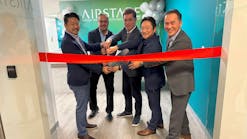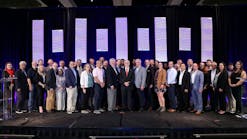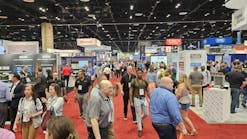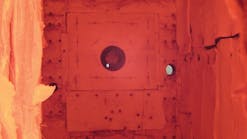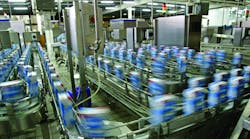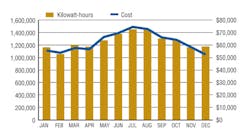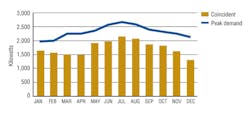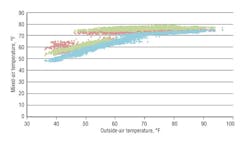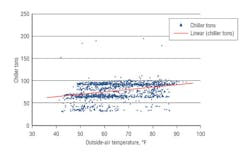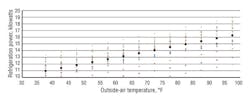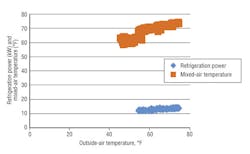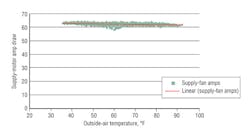Within large industrial corporations, facility maintenance often is viewed as no more than an operating expense. Many such organizations scoff at even a one-year payback for energy-saving projects, choosing instead to focus on the near-instantaneous returns offered by improvements in manufacturing efficiency. In northern Colorado, however, one manufacturer is working hard to change the way the economic benefits of energy efficiency are perceived and accounted for, recognizing facility energy-cost savings as a key contributor to the overall profitability of an organization.
In 2005, the company set a course for increased maintenance efficiency. In 2008 and 2009, it invested roughly $250,000 in building-automation controls, lighting retrofits, and the installation of variable-speed compressors at two sites. The project received $120,000 in rebates from the local utility and resulted in a reduction in electricity consumption of roughly 9 percent, or 2 million kWh of electricity annually. Still, the company was not satisfied. In late 2011, seeking more opportunities to reduce energy costs, it decided to undertake the process of retrocommissioning.
The retrocommissioning project was a public-private partnership between the owner, the commissioning provider, and local utilities. One of the utilities operates a demand-side-management program whereby it pays the entire cost of an engineering study identifying low- and no-cost energy-saving measures and methods to improve a building’s comfort, operation, and efficiency; in return, the owner agrees to implement opportunities with a simple payback of less than two years.
The commissioning provider initially set its sights on electricity savings, as roughly 87 percent of the facilities’ annual energy expenditures was related to electricity, with the remaining 13 percent related to natural gas. Figures 1 and 2 show the 2011 electrical-energy and demand profiles for one of the facilities, which are similar to the other facility’s. Note the relatively flat load profile indicative of an industrial facility with high internal loads. Kilowatt-hours per month varies less than 15 percent from its maximum during the year. For these facilities, building-envelope measures would have had little effect on overall energy reduction. Areas of focus were cooling systems and, to a lesser extent, lighting systems.
Electrical demand rates were based on both a coincident peak (based on utilitywide peak demand) and actual facility demand peaks. A typical monthly peak-demand profile is shown in Figure 2. Interestingly, only 12 one-hour periods over the course of a year usually determine more than 40 percent of annual electricity bills because of coincident peak charges. Therefore, it was imperative to address peak demand charges as well.
At the facility in figures 1 and 2, the HVAC equipment primarily consists of seven original constant-volume multizone (MZ) air-handling units (AHU) with chilled-water coils and roughly 46 small-tonnage direct-expansion (DX) rooftop units (RTU). Two 200-ton air-cooled chillers provide chilled-water cooling. The equipment also includes four gas-fired hot-water boilers, one steam boiler, and myriad exhaust fans.
Portable trend loggers were installed to supplement trend data from the building automation system. To manage the cost of the trending, a statistical sampling of each size of HVAC unit was taken, with more data collected from the larger equipment. Key findings included:
• Many outdoor-air economizers were not functioning optimally, and outdoor-air intakes were restricted and limiting use of outdoor air for “free cooling.” A semi-arid climate makes Colorado one of the best locations in the country for use of outdoor air for free cooling.
Figure 3 compares mixed-air temperature and outdoor-air temperature for three of the MZ AHU. Note how warm the mixed-air sections are when the outdoor-air temperature is below 55°F dry bulb. Figure 3 indicates significant potential for use of more free outdoor-air cooling and less mechanical cooling.
A plot of lead-chiller tonnage is shown in Figure 4. Note the significant chiller-tonnage production below 55°F outdoor-air temperature, when outdoor air alone typically can be used for cooling.
A plot of the smaller DX RTU (Figure 5) shows significant refrigeration-compressor cooling power at outdoor-air temperatures of 35°F to 55°F, when outdoor air can be used and compressors shut off.
• Many of the MZ AHU exhibited damper leaks causing thermal pollution from the hot deck to the cold deck.
• The MZ AHU and RTU were running 24 hr a day, regardless of occupancy or load.
• The pond-fountain pump was running continuously.
To remedy these problems, the following actions were taken:
• Refrigeration-based cooling was reduced through control modifications (up to 75°F outdoor air per ASHRAE guidelines for this climate zone), allowing more outdoor air for free cooling on RTU and MZ AHU. Additionally, outdoor-air intakes were enlarged, and the discharge-air setpoint was reduced to 55°F.
• Fifty-five-degree-Fahrenheit outdoor-air-temperature cut-outs were installed for all cooling compressors. An example from verification trending is shown in Figure 6. Note refrigerant cooling stops when outdoor-air temperature drops below 55°F. Also, cooler mixed air is provided by the repaired RTU economizer section. Mixed-air temperature drops as low as 57°F without the compressors running.
• Low-leak zone-damper gaskets were installed on the MZ-AHU hot decks to save fan and cooling energy.
• Variable-frequency drives (VFD) were installed on MZ-AHU supply fans.
• The MZ AHU were cycled during unoccupied periods.
• Pumps were cycled off when chillers were not running.
• Soft and stagger starting of primary cooling and HVAC equipment was implemented to obviate the peak demand.
• The pond-fountain pump was scheduled off at night.
At the other facility, the HVAC equipment includes 11 AHU and two 530-ton centrifugal chillers. Two 600-ton cooling towers provide free cooling via waterside economizer to the AHU during cooler months, while two 6-MMBtu-input, gas-fired hot-water boilers provide heating water. The commissioning provider discovered:
• Many outdoor-air economizers were not functioning optimally, limiting the use of outdoor air for free cooling. Mixed-air-section temperatures were too high.
• Many AHU fans were operating at peak power, and the VFD were not modulating down.
• AHU and chiller-system pumps were running 24 hr a day, regardless of occupancy or load. One such example with constant amp draw through all outdoor temperatures is shown in Figure 7.
• Towers and chillers had tube and plate fouling.
• Diverting valves were restricting flow through the chillers and decreasing chiller efficiency during cool weather.
• The condenser-water pump ran 24/7/365, causing tower freezing and fill damage during low winter-season loads.
• The changeover from chiller cooling to waterside economizer was not automated.
To remedy these problems, the following actions were taken:
• Refrigeration-based cooling was reduced through AHU control modifications, which allowed the use of more outdoor air for free cooling, and the discharge-air setpoint was lowered, which allowed the AHU fans to slow down.
• Variable-speed drives were installed on the condenser-water pumps to reduce overpumping and protect the towers during cold weather.
• Fouled chiller and tower heat-transfer tubes were cleaned.
Retrocommissioning yielded the following verified results:
• Annual electrical savings: 1.4 million kWh (MWh)—over 5 percent of 2011 energy use.
• Annual electricity-cost savings: $57,000.
• Average winter demand savings: 50 kW.
• Average summer demand savings: 35 kW.
• Utility rebates: $55,000.
• Net project costs: $48,000.
• Simple payback: 0.8 year.
Additionally, retrocommissioning uncovered many energy-saving capital projects, including lighting-control-system, boiler-plant, heat-recovery, and steam-system improvements. Most of these projects have simple paybacks of more than two years and higher installed costs and, thus, have not yet been implemented.
Commissioning verification was completed in late 2013.
Retrocommissioning has proved to be a win-win for the company and local utilities. For the company, additional profit exists through energy savings, reduced maintenance costs, and improved control of the working environment. For the local utilities, retrocommissioning is helping energy-reduction targets to be met.
The company is planning to replicate what was done in Colorado at other facilities.
A member of HPAC Engineering’s Editorial Advisory Board, Peter D’Antonio, PE, CEM, LEED AP, is president of PCD Engineering Inc., provider of building energy analysis, mechanical/electrical design, and commissioning. His work has been recognized with design and service awards from organizations such as the U.S. Environmental Protection Agency, the U.S. Green Building Council, the Colorado Governor’s Energy Office, and the Colorado Renewable Energy Society.
Did you find this article useful? Send comments and suggestions to Executive Editor Scott Arnold at [email protected].
